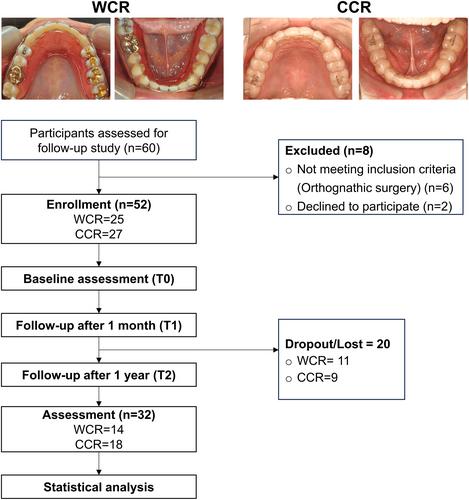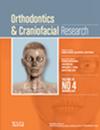Retention efficacy and patient experience with customized clear retainer and wrap-around circumferential retainer among non-extraction orthodontic patients: A 12-month follow-up cohort study
Abstract
Objective
The aim of this study was to evaluate retention efficacy by assessing retention stability and patient perspectives according to type of circumferential retainer: the wrap-around circumferential retainer (WCR) and customized clear retainer (CCR).
Materials and Methods
This cohort follow-up study involved 52 patients aged 18–62 who underwent fixed-appliance orthodontic treatment without extractions or orthognathic surgery. Following screening consenting participants were divided into WCR and CCR groups. All participants before follow-up received fixed retainers for the upper and lower anteriors and respective removable retainers within 2 weeks post-debond. Intraoral scans and lateral cephalograms were taken immediately after debonding (T0) and again 12 months later. Dentoalveolar changes in several measurements were compared to evaluate retention efficacy. Surveys were conducted at 1 month (T1) and 12 months (T2) post-debonding to assess changes in patient experiences. Outcome assessments were blinded. Paired T-tests and independent T-tests were used for intragroup and intergroup comparisons of dentoalveolar measurements, respectively. Survey responses were analysed using the Pearson Chi-Square test.
Results
The final assessment included 32 participants. Model analysis revealed no significant differences between the groups, except for maxillary intermolar width (p = .033). In the WCR group, the cephalometric analysis indicated a significant increase in the incisor mandibular plane angle (p = .002) and a decrease in the interincisal angle (p = .014), while changes in the CCR group were statistically non-significant. Patient attitude evaluation showed similar trends for wear time and overall satisfaction. However, a higher percentage of respondents in the WCR group reported irritation when wearing the retainers (p = .037) at T1 and discomfort related to speech (p = .038) at T2.
Conclusions
CCR showed better retention efficacy in terms of lower incisor inclination. Patients experienced relatively less irritation and speech discomfort with CCRs.


 求助内容:
求助内容: 应助结果提醒方式:
应助结果提醒方式:


